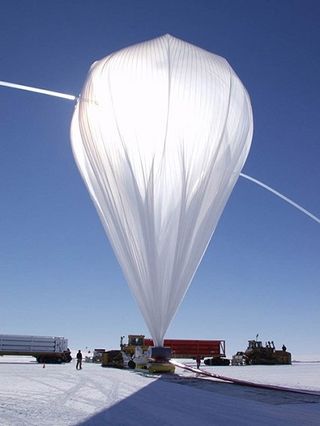Enormous Balloon Will Carry Black Hole Hunting Telescope Aloft

A new telescope designed to spot black holes will take off this month, but it won't launch atop a rocket. Instead, a giant balloon that can fit an entire 747 jetliner inside it with room to spare will carry the telescope high into the atmosphere.
The balloon will rise about 120,000 feet (36,576 meters) above Earth, or about three or four times the height that most commercial airliners cruise. From that lofty perch, above 99 percent of Earth's atmosphere, X-Calibur will search for black holes and clues about how they fit Einstein's theory of general relativity.
Scientists aimed to launch X-Calibur last year, but wind conditions prevented the launch. Now, if the weather cooperates, scientists at Washington University in St. Louis and NASA's Columbia Scientific Balloon Facility (CSBF) in Texas plan to launch the balloon in Fort Sumner, New Mexico, around the middle of September. Henric Krawczynski, a professor of physics at Washington University who is leading the project, said earlier this week there was still no official launch date, but it could happen as early as this weekend. [Earth from Above: 101 Stunning Images from Orbit]
X-Calibur is a specialized type of telescope called a polarimeter that measures polarized, high-energy X-rays. X-Calibur will sail up to the outer bounds of Earth's atmosphere and focus on various celestial objects, including black holes visible from the Northern Hemisphere.
A black hole's gravity is so powerful that even light can't escape its pull. That's why black holes appear invisible. X-Calibur will spot the black holes by looking for X-rays emitted by matter just before it disappears inside the black hole.
Astronomers are only just beginning to study these high-energy, polarized X-ray lights. Polarization can happen when light is reflected or scattered. Polarized X-rays could help scientists determine the size of black holes and how fast they are spinning. Einstein's theory of general relativity established a maximum rotation rate for black holes, and astronomers hope X-Calibur will reveal more about their spin.
Preparing to launch
Sign up for the Live Science daily newsletter now
Get the world’s most fascinating discoveries delivered straight to your inbox.
Scott Barthelmy, a researcher at NASA's Goddard Space Flight Center in Greenbelt, Maryland, described the complicated pre-launch procedure needed to inflate the balloon and prep X-Calibur for flight. The first step will be to roll out the ultra-thin plastic sheets of the balloon. Hoses will then pump pressurized helium into the balloon, which will expand and cause the balloon to rise in a mushroom-shaped cloud, until the 40-million-cubic foot (1,132,674 cubic meters) interior is full.
The ground weight will then be lifted off the balloon to let it rise. About 900 feet (274 m) of balloon material will be rolled out on the ground, and as the balloon rises it will pick up more and more of this train. The very end of the balloon will be attached to X-Calibur.
A small crane will cradle X-Calibur about 10 feet (3 m) over the ground. When the balloon drifts directly over the telescope and begins pulling up, a technician will be standing by to release the telescope from the crane. If the release comes too early, the telescope could drop to the ground and smash. If it comes too late, the crane release could jam.
NASA's Columbia Scientific Balloon Facility website will host a live broadcast of the launch, which the scientists expect will happen around Sept. 14 or 15, if weather conditions allow. After the balloon launches, anyone can track its progress with a live Google map.
Follow Kelly Dickerson on Twitter. Follow us @livescience, Facebook & Google+. Original article on Live Science.

